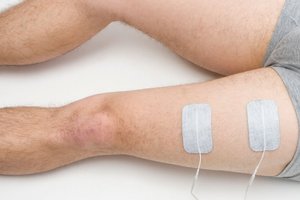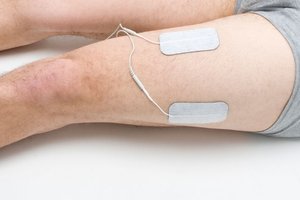Soft tissue thigh injuries include quadricep muscle strain, and tendon rupture
Thigh injuries
Quadricep muscle strain
A thigh strain refers to an injury where the fibres in a quadricep muscle are overstretched. Once the fibres are overstretched to a certain point, muscle tears can occur. These can vary from a minor strain to a full thickness muscle tear.
There are a number of factors which can increase the risk of straining a thigh muscle. The most common include muscle tightness, fatigue or imbalance. Other factors are poor exercise technique and an inadequate warm-up. The biggest contributory factory to a repeat injury is a previous thigh strain/tear without adequate rehabilitation.
There are four muscles within the quadricep, but the most frequent source of injury to this area occurs when muscle fibres at the head of the rectus femoris muscle are ruptured.
Tendon rupture
Severe cases may involve rupture of the junction between the tendon and the muscle, which may lead to a permanent weakness.
Corked thigh
A “corked thigh” is a muscle contusion, caused by a severe impact to the muscles of the thigh causing damage such as internal bleeding and inflammation. A haematoma (collection of blood in the tissues) in the quadriceps muscle may occur.
Referred pain
If your thigh pain is associated with back, hip, buttock or knee pain, referred pain from the back, hip or sacroiliac joint, is often the cause of symptoms. Treat these conditions at the source.
SportsMed TENS therapy for thigh injuries
After a diagnosis of a thigh injury, your management plan should include physical therapy treatment as often as possible.
SportsMed is the TENS, ECS and EMS machine we suggest to aid repair of a thigh injury.
SportsMed electrotherapy can be used everyday - between visits to the clinic - for drug-free, on-demand pain relief. It is also designed and programmed to aid circulation, reduce inflammation, hasten healing and help with quadriceps muscle strengthening.
User guide
Please read the User Guide which comes with your TENS unit
Pad placement - Thigh injuries
Pain relief - place pads where they are comfortable and most effective for pain relief
Injury healing - pads are placed at the location of the injury
Muscle rehabilitation - the generic advice is to place one pad at the top of the muscle and the second pad one-third along the length of the muscle you wish to strengthen. You may need to consult your physiotherapist for specific guidance on which muscles to target.
If you have any questions please phone our office for further advice.




